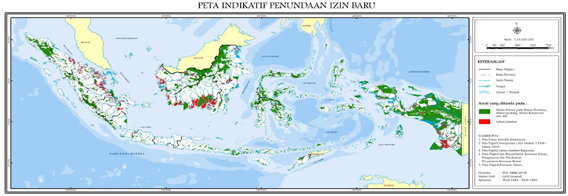Indonesia's moratorium will not significantly reduce emissions, but has other benefits, finds analysis
Indonesia's moratorium on new forest concessions alone "does not significantly contribute" to its goal of reducing greenhouse gas emissions 26 percent from a projected 2020 baseline, concludes a new analysis by the World Resources Institute (WRI)
mongabay.com | February 27, 2012
However the study says the moratorium does support the target in the long-term by creating a window for enacting governance reform needed to stop destructive business-as-usual approaches to forest management.
"Although there are 43.3 million hectares of primary forests and peat lands and significant carbon stocks within the boundaries of the indicative moratorium map, the questionable status of secondary forests, the exemption of existing concessions, and the limited enforcement of the moratorium boundaries may result in gains being negated by other land-use emissions," states the analysis, which was authored by WRI's Kemen Austin, Stuart Sheppard, and Fred Stolle. "Nonetheless, long-term positive impacts can still be achieved if significant governance reforms are accomplished during the moratorium period."
Indonesia's moratorium on new plantations and logging concessions in primary forests areas and peatlands was implemented in May 2011 under its climate action plan, which aims to substantially reduce carbon emissions from deforestation and degradation of peatlands and forests. But the moratorium was substantially weaker than expected, with many exemptions, including a free pass to convert secondary forests and loopholes for mining and energy development. Environmentalists immediately expressed disappointment with the moratorium and raised a number of concerns, some of which are now seconded by the working paper from WRI.
Indonesia’s moratorium on new forest concessions: key findings and next stepsreports that some "3.5 million ha of primary and peat forests inside the moratorium boundaries are not protected". Conversion of this land could release 14.6 billion tons of carbon dioxide. It notes that since much of the area covered by the moratorium was already legally conserved, the government's plan only increases the forest and peatland acreage under protected by 11.3 million ha — 26 percent of the total moratorium area. Another 15.6 million ha of the moratorium area includes secondary forest, which isn't explicitly protected, potentially putting it in limbo. Finally the report cites research showing that the moratorium isn't being respected — more than 100 new clearings were detected in off-limits areas during the initiative's first three months.
Still the working paper finds reason for hope. It says that despite its weaknesses, the moratorium "pauses" some business-as-usual patterns that have destroyed vast tracts of Indonesian forest over the past half-century. Opportunities for improvement during that window include fostering transparency in land use; governance reform, including processes for allocating forestry permits; strengthening monitoring and law enforcement; boosting coordination between ministries; establishing performance-based metrics; and encouraging a shift toward low carbon development.
"The moratorium creates incentives for increased productivity and the use of low carbon degraded land, rather than forests or peat lands, as a viable alternative for agricultural and forest plantation expansion," said WRI. "Any agricultural expansion should be confined to those deforested, non-peat lands and implemented in a manner that fully respects the rights of indigenous peoples and local communities."
Sign warning that a rainforest tree has been spiked to discourage illegal logging in Indonesian Borneo. Photo by: Rhett A. Butler.
Already there are signs of change. Last year, Kuntoro Mangkusubroto, head of the Indonesian President’s REDD+ Task Force, said the government would immediately work to implement a decade-old law that requires recognition of adat or customary rights. The effort will include developing a land tenure map so government agencies can better understand how communities are using land and delineating the legal status of the Indonesia's forest area, which could help keep more forest standings. At the same time, PT SMART announced it will no longer convert land with more than 35 tons of carbon for plantations, becoming the first palm oil major in Indonesia to agree to such restrictions. Finally, WRI and local partners are developing a near-real-time forest monitoring tool that uses satellite imagery to detect deforestation, creating what could become a powerful tool for law enforcement, provided there is sufficient political will to crack down on business-as-usual.
But for all the positives, the question of political will remains critical. To date, the push to break from the business-as-usual course in the forestry sector has been supported by Indonesian President Susilo Bambang Yudhoyono, who has said he wants his legacy to his grandchildren to be Indonesia's forests. Once SBY leaves office, it's unknown whether his successor will share his zeal.











No comments:
Post a Comment